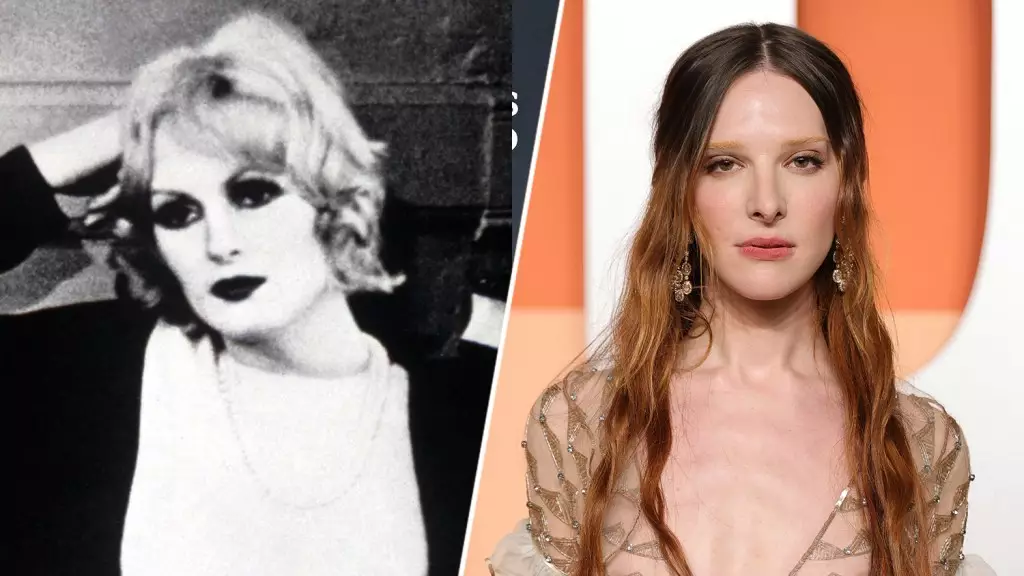In an ambitious endeavor that illuminates the life of Candy Darling, a prominent figure in LGBTQ history and Andy Warhol’s artistic circle, actress Hari Nef has taken on both the role of performer and storyteller. The history of biographical films has frequently been criticized for oversimplifying complex lives, but Nef’s approach appears to counter this trend. By describing her vision for the film as a deeply personal project, she imbues it with authenticity and emotional depth that is necessary for illustrating Darling’s life, which was replete with struggles and triumphs.
Nef’s announcement that she is now writing the script herself is not merely a change in personnel; it marks a pivotal moment in the project’s trajectory. The journey of the film began over six years ago, reflecting Nef’s unwavering commitment to ensuring Darling’s legacy is told with the nuance it deserves. It is not enough to cast a merely performative light on figures such as Darling, who holds an important place within the annals of LGBTQ history. Thus, Nef’s insistence on thoroughly researching her subject matter is commendable and necessary; she recognizes that understanding the full breadth of Darling’s experiences is non-negotiable in portraying her accurately.
The Challenge of Authenticity
One particularly striking aspect of Nef’s comments is her acknowledgment of the financial constraints surrounding this project. Her declaration that they have “zero dollars and zero cents” adds a layer of realism to the ambitious vision. Fundraising and casting process at this stage can often feel daunting, especially for a story that needs a significant amount of sensitivity and authenticity to resonate with audiences. It raises an important question: can the artistic vision be achieved without financial backing? Nef stands at the crossroads of artistry and pragmatism, seeking to blend sincerity with the practicalities of filmmaking.
Yet, her journey is filled with reflections on identity that resonate beyond the scope of the film itself. Speaking candidly about her own experiences as a trans actress, Nef recognizes that Candy’s legacy isn’t just a narrative to be told—it’s a mirror reflecting the struggles faced by many today. Her assertion that Candy “was out of her time” highlights a broader discussion surrounding the necessity of representation in cinema. In a culture where many stories remain untold or oversimplified, Nef’s effort to carve out a candid portrayal of Darling could provide catharsis not just for her, but for countless others who see their stories echoed in Darling’s tumultuous life.
The Heart of the Story
Candy Darling remains an iconic figure because of her contributions to the arts, and finding the right way to encapsulate her spirit in a film presents a unique challenge. The description of the film as “a showbiz movie” allows us to anticipate an exploration that highlights both her artistic ventures and the societal limitations she faced. Such duality is crucial; any successful biopic must navigate the contrasting territories of ambition and constraint, especially for a pioneer like Darling, who danced at the intersection of societal norms and personal authenticity.
Moreover, Nef’s desire to portray Darling with “sensitivity” touches upon an essential element of storytelling that can often be overlooked—how historical figures would wish to be represented. This brings forth questions about agency in storytelling, especially for individuals from marginalized backgrounds. Nef’s approach demonstrates an earnest effort to honor that agency while simultaneously acknowledging the discomfort of truth. By appreciating the multifaceted nature of Candy’s character, the film seeks to transcend simplistic characterizations, injecting complexity into a narrative that has been largely defined by superficial glances.
The Personal Preparation: A Transformation
Intriguingly, Nef’s preparations for embodying Darling have included tangible transformations, such as altering her appearance to mirror that of the beauty icon. Such dedication speaks volumes about the lengths actresses are willing to go to create compelling portrayals. This commitment to authenticity, however, carries its own weight. As Nef deliberates about shaving her eyebrows thinner and working closely with hair specialists, it serves as a metaphor for the sacrifices many make in the pursuit of identity and self-definition.
This journey is symbolic, melding the external with the internal and demonstrating that portraying a figure like Darling isn’t merely about mimicking appearance; it’s about understanding the emotional landscape of someone who lived boldly despite societal constraints. This metamorphosis reflects the core of Nef’s endeavor—a deep dive into not just the life of a historical figure but the effects that such a life can have on those who draw inspiration from it.
In her heartfelt quest to tell Candy Darling’s story, Nef represents a new wave of filmmakers who dare to both illuminate the past and create a pathway for meaningful representation in the future.

